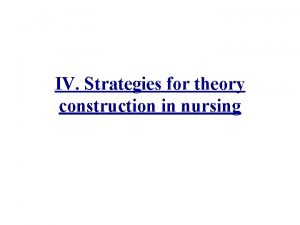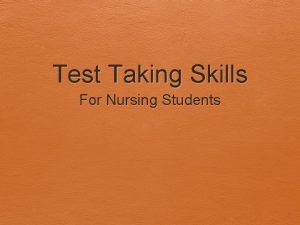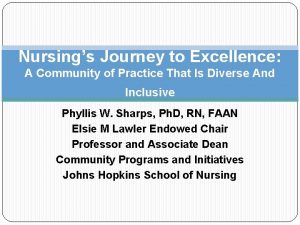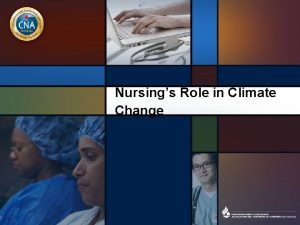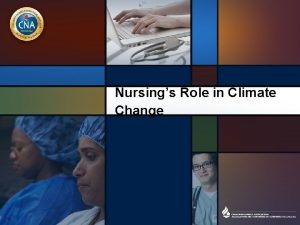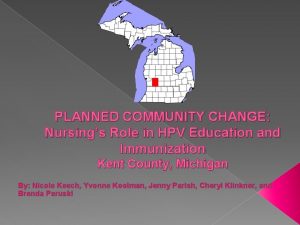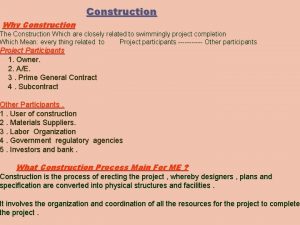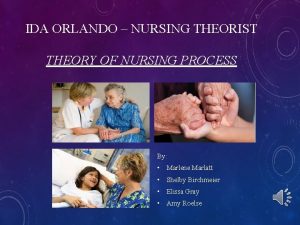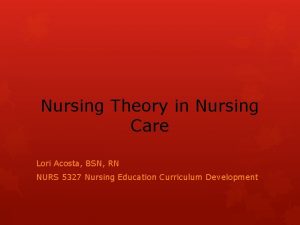IV Strategies for theory construction in nursing Nursings























- Slides: 23

IV. Strategies for theory construction in nursing

Nursing’s Fundamental Patterns of Knowing 1. Empirics: The science of nursing 2. Ethics: The moral component of knowledge in nursing 3. Personal knowing in nursing 4. Aesthetics: The art of nursing

Conceptual Themes in Nursing Theories and Frameworks 1. The nature of nursing 2. The nature of person 3. Society and environment 4. Health

Metatheory Level Clarifies Provides material for Grand Theory Level Guides Refines Middle-Range Theory Level Directs Practice Theory Level Test in practice

Concept Development Concept Revision Statement Development Theory Development Statement Revision Theory Testing Theory Revision Concept Development

Types of Theory Fawcett & Downs, 1986 • Descriptive theory- state “What is”. • Explanatory theory- explain how the parts of a phenomenon are related to one another • Predictive theory- addresses cause and effect

Types of Theory(con. ) Chinn & Kramer, 1999 • Meta-theory: theory about the nature of theory and the processes for its development. • Grand theory: theory that deals with broad goals and concepts representing the total range of phenomena of concern within a discipline.

• Midrange theory: substantive theory that tends to cluster around a concept of interest to nursing; theories of pain alleviation, fatigue, or uncertainty represent theory in the midrange. • Microtheory: theory that is relatively narrow in scope or deals with a narrow range of phenomena. ◎Grounded theory: theory generated from inductive research processes

Theory Formalization (I) Fawcett & Downs, 1986 1. Concepts(Pragmatics of concept identification and classification) 2. Definitions 3. Proposition 4. Hierarchies of proposition 5. Components of Theory Analysis

Components of theory analysis 1. Concepts: Word or collections of words Expressing mental images of phenomenon • Pragmatics of concept identification • Pragmatics of concept classification

Components of theory analysis(con. ) 2. Definitions: Meanings given to concepts Constitutive definition Operational definition Empirical indicator Pragmatics of definition identification and classification

Components of theory analysis(con. ) 3. Propositions: Statements about one or more concepts Non-relational proposition Relational proposition Hypothesis Pragmatics of proposition identification and classification

Components of theory analysis(con. ) 4. Hierarchies of propositions: Arraignments of propositions according to their levels of abstraction Inductive proposition test Deductive proposition seat Sign of a relationship Pragmatics of hierarchical ordering of propositions

Components of theory analysis(con. ) 5. Diagrams: Pictorial representation of concepts and their connections 6. Conceptual- theoretical-empirical structures: Diagrams depicting the connections between conceptual model concepts, concepts of a theory, and empirical indicators

Theory Formalization (II) Chinn & Jacobc, 1987 1. Concepts 2. Definitions 3. Goals 4. Relationships 5. Structure 6. Assumptions

Description of the Theory Chinn & Kramer, 1999 • What is the purpose of this theory? • What are the concepts of this theory? • What are the definitions in this theory? • What relationships are in this theory? • What is the structure of this theory? • What assumptions are in this theory? Forming a complete description

Conclusion

What is this? How does it work? Conceptualizing Structuring Empirics Theories Formal Descriptions Validation Confirmation Dialogue Justification Do I know what I do? Do I do what I know? Opening Centering Personal stories Genuine Self Scientific competence Moral/ethical comportment Therapeutic Use of Self Is this right? Is this responsible? Response reflection Transformative Art/acts Principles Codes Ethics Personal Appreciation Inspiration Criticism Work of art Exploring Clarifying Envisioning Rehearsing Peggy L. Chinn, Maeona K. Kramer(2011). Integrated theory and knowledge development in nursing. Fundamental patterns of knowing, P. 13 Aesthetics What dose this mean? How is it significant?

Peggy L. Chinn, Maeona K. Kramer(2011). Integrated theory and knowledge development in nursing. Fundamental patterns of knowing, P. 14 -15

Empirics-the science of nursing • Empirics knowing according to Chinn and Kramer (1999, 4) and after Carper(1978) is expressed in practice through the nurse’s scientific competence.

Aesthetics-the art of nursing • Both Carper (1978) and Peplau (1988) claim nursing lost sight of its art in the pursuit of its science.

Personal knowing • Personal knowing according to Carper (1978, 18) is concerned with ‘the knowing, encountering and actualizing of the concrete, individual self. ’

Ethical knowing • In this pattern of knowledge referred to as ethical knowing, Carper (1978. 21) stated ‘the examination of the standards, codes and values by which we decide what is morally right should result in a greater awareness of what is involved in making moral choices and being responsible for the choices made ’
 Strategies for theory construction in nursing
Strategies for theory construction in nursing Test taking strategies for nursing students
Test taking strategies for nursing students Fspos
Fspos Typiska drag för en novell
Typiska drag för en novell Nationell inriktning för artificiell intelligens
Nationell inriktning för artificiell intelligens Ekologiskt fotavtryck
Ekologiskt fotavtryck Varför kallas perioden 1918-1939 för mellankrigstiden
Varför kallas perioden 1918-1939 för mellankrigstiden En lathund för arbete med kontinuitetshantering
En lathund för arbete med kontinuitetshantering Underlag för särskild löneskatt på pensionskostnader
Underlag för särskild löneskatt på pensionskostnader Personlig tidbok
Personlig tidbok Anatomi organ reproduksi
Anatomi organ reproduksi Densitet vatten
Densitet vatten Datorkunskap för nybörjare
Datorkunskap för nybörjare Tack för att ni lyssnade bild
Tack för att ni lyssnade bild Debatt mall
Debatt mall Delegerande ledarstil
Delegerande ledarstil Nyckelkompetenser för livslångt lärande
Nyckelkompetenser för livslångt lärande Påbyggnader för flakfordon
Påbyggnader för flakfordon Tryck formel
Tryck formel Svenskt ramverk för digital samverkan
Svenskt ramverk för digital samverkan Kyssande vind
Kyssande vind Presentera för publik crossboss
Presentera för publik crossboss Jiddisch
Jiddisch Bat mitza
Bat mitza
